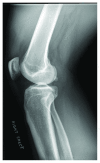Ultrasound Evaluation and Surgical Excision of a Fabella Causing Peroneal Neuropathy in a Track Athlete
- PMID: 30693123
- PMCID: PMC6332997
- DOI: 10.1155/2018/2371947
Ultrasound Evaluation and Surgical Excision of a Fabella Causing Peroneal Neuropathy in a Track Athlete
Abstract
Background: There are multiple causes of posterior knee pain and radicular symptoms. A symptomatic fabella is a rare cause but should be considered in the differential diagnosis.
Purpose: Physicians should consider a symptomatic fabella as a diagnosis when common treatments for posterior knee pain have not alleviated the symptoms.
Study design: Case report.
Methods: Review of clinical documentations of an orthopedist, physiatrist, physical therapist, 2 primary care sports medicine physicians, and the surgical report of an orthopedist.
Results: It took time and resources including several referrals and imaging modalities to make a final diagnosis.
Conclusion: Symptomatic fabellae are an uncommon finding but should be considered in the differential diagnosis with an athlete with posterior knee pain.
Clinical relevance: Considerable time and resources were used to ultimately diagnose and treat a NCAA Division 1 athlete. Surgical excision was required of a sesamoid bone that is present in 30% of individuals.
Figures






References
-
- Hire J. M., Oliver D. L., Hubbard R. C., Fontaine M. L., Bojescul J. A. Snapping knee caused by symptomatic fabella in a native knee. American Journal of Orthopedics. 2014;43(8):377–379. - PubMed
-
- Yamamoto T., Ito M. A case report of peroneal nerve palsy by compression of the fabella. The Journal of the Japanese Orthopaedic Association. 1964;38:p. 1005.
Publication types
LinkOut - more resources
Full Text Sources

